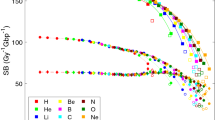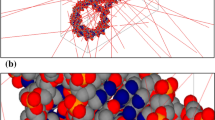Abstract
The yield of DNA double-strand breaks (dsb) and DNA complex lesions induced by protons and α-particles of various energies was simulated using a Monte Carlo track structure code (MOCA15) and a simple model of the DNA molecule. DNA breaks of different complexity were analysed. The linear energy transfer (LET) and particle-type dependence of lesions of higher complexity seems to confirm the importance of clustered damage in DNA as a relevant step leading to biological endpoints such as cell inactivation. The detailed structure of proton and α-particle tracks was analysed to identify the main characteristics possibly responsible for such a dependence. The role of the primary ion and of its secondary electrons in inducing dsb and complex lesions is described, showing that the relative contribution of secondary electron tracks alone in inducing clustered lesions is almost negligible at high LET, but tends to dominate below ≈10 keV/µm. This is consistent with the observed similar effectiveness of low-LET fast particle radiation and sparsely ionizing radiation such as x-rays. The dependence on LET and particle type is mainly due to energy deposition events of the primary ion together with short range electrons surrounding the ion track; the yield of complex lesions due to secondary electron tracks alone is substantially LET independent. The radial distributions of the energy contributing to the induction of complex lesions were analyzed and compared with the radial distributions of energy deposition of the full tracks. The results suggest that the stochastic behaviour (i.e. cluster properties) of the energy deposition pattern within a radius of a few nanometers around the ion track plays a relevant role in determining the biological radiation effectiveness.
Similar content being viewed by others
Author information
Authors and Affiliations
Additional information
Received: 20 December 1996 / Accepted in revised form: 5 March 1997
Rights and permissions
About this article
Cite this article
Ottolenghi, A., Merzagora, M. & Paretzke, H. DNA complex lesions induced by protons and ⋅-particles: track structure characteristics determining linear energy transfer and particle type dependence. Radiat Environ Biophys 36, 97–103 (1997). https://doi.org/10.1007/s004110050060
Issue Date:
DOI: https://doi.org/10.1007/s004110050060




